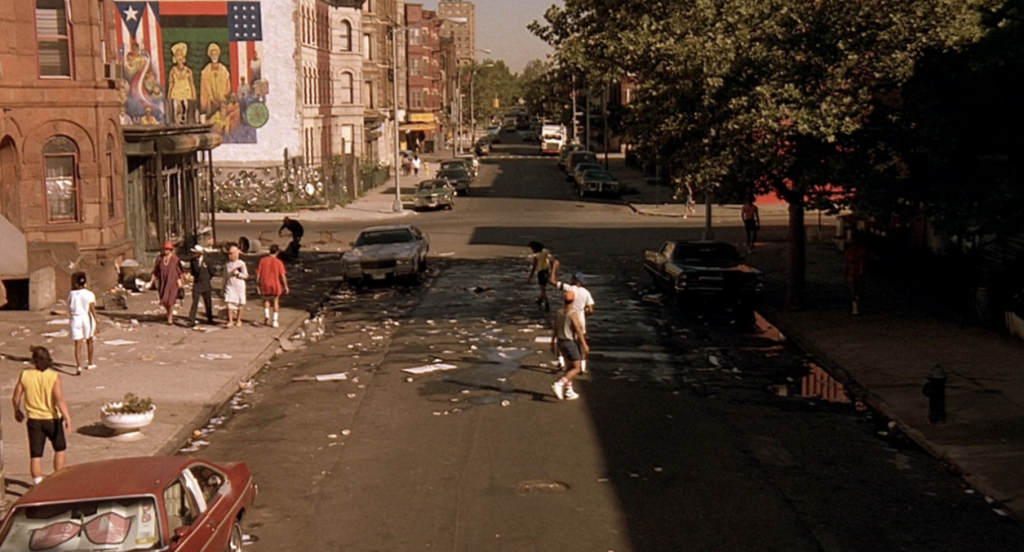If you’ve ever spent a full summer day in Brooklyn, you’ll know what it feels like when even the air seems heavy with tension. The heat isn’t just a matter of temperature—it’s an emotional state, a slow simmer of frustration, injustice, restlessness. Do the Right Thing, Spike Lee’s 1989 masterpiece, captures that feeling with stunning precision. In just two hours, the film builds a powder keg of community tension, racial friction, and boiling anger—and then strikes the match.
Spike Lee wasn’t just behind the camera for this one—he wrote it, directed it, and played Mookie, a pizza delivery guy for a local Italian-American joint. At first glance, Mookie is unassuming, almost passive. But as the story unfolds, we come to see how even the quietest person can become the catalyst for something explosive.
Set on the hottest day of the year in Brooklyn’s Bedford–Stuyvesant neighborhood, the film slowly introduces us to the people who live there: Sal, the Italian-American pizzeria owner (played brilliantly by Danny Aiello), the always-sweating DJ Mister Señor Love Daddy (Samuel L. Jackson), the towering and furious Radio Raheem with his ever-blasting boombox, and many more. The film opens like a portrait of community life—chatty, humorous, noisy—but beneath the surface, a storm is brewing.

There’s a deceptive ease to the film’s rhythm. You laugh at the neighborhood banter, nod at the social commentary, and begin to feel almost at home. And then—without ever turning didactic or preachy—it all unravels. The killing of Radio Raheem by police, Mookie’s response, the shattering of the pizza shop window… It’s sudden, violent, and unforgettable. But Spike Lee isn’t asking you to choose a side. He’s forcing you to confront the question at the core: What is the right thing to do?
I remember watching this film in college during a Black Cinema month. It was raining outside, the kind of steady rain that makes the classroom feel like a bubble. Sitting next to me was Jacob, a blond kid from Connecticut who said he’d never had a real conversation with a Black neighbor. After the film, he looked like he’d swallowed something heavy. “I think I finally get why the fried chicken place back home closed after six months,” he mumbled. We didn’t speak much after that, but something had clearly shifted.
That’s the real power of this movie. It doesn’t give you clean answers or moral lessons wrapped in a bow. It hands you a mirror. It puts the pressure on you to examine your silence, your biases, your version of “doing the right thing.”
Even today, over three decades later, Do the Right Thing feels disturbingly current. After the killing of George Floyd in 2020, the film saw a resurgence in viewership. Many called it “prophetic.” But it’s not prophecy—it’s documentation. It doesn’t predict what will happen. It reflects what keeps happening, in neighborhood after neighborhood, generation after generation.

One of the most powerful moments in the film is its final juxtaposition: two quotes, one from Malcolm X defending self-defense, and the other from Martin Luther King Jr. condemning violence. The film doesn’t choose between them—it presents both, because real life rarely gives us clear lines. The community in the film is flawed, chaotic, and raw. But it is real.
If you’re used to watching slick Hollywood blockbusters, this film might feel jarring at first. It doesn’t follow a traditional structure. There’s no catharsis where justice prevails or the villain repents. Instead, you get a tangle of human messiness. And that messiness is the point.
I find myself thinking about Radio Raheem’s rings—LOVE and HATE—like two opposing forces in a constant fistfight. They aren’t just symbols; they’re a daily reality for people who feel caught between wanting peace and needing to be heard.
These days, people talk a lot about “emotional value” in films, the idea that a movie should make you feel seen. But Do the Right Thing doesn’t just make you feel—it makes you squirm. It presses against your comfort zones, and forces you to wrestle with contradictions. That’s not a flaw—it’s the genius.

And for those building a film blog or curating essential movie lists, this one isn’t optional. It’s not just a cinematic classic—it’s a cultural litmus test. One of those rare films that doesn’t age—it just gets sharper with time.
So the next time you feel the heat rising—on the street, on the news, in your gut—remember the lesson of this film: Sometimes, doing the right thing doesn’t feel right at all. But that doesn’t mean it isn’t necessary.
